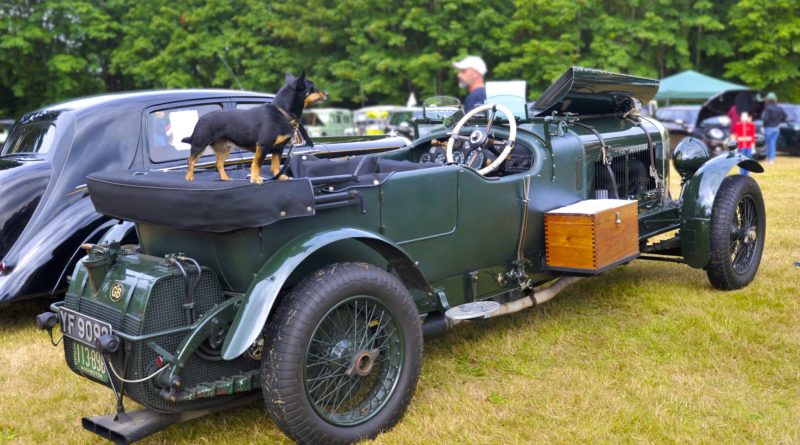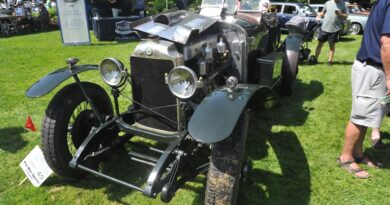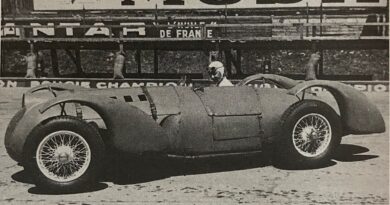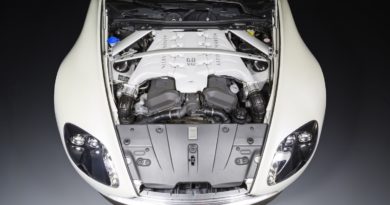1926 Bentley 6-1/2 Liter “Woolfe” Speed Six
At a time when a Model T cost $290, this Bentley, known as Woolfe (we will get to why later), stickered for $16,600. Only one thing – Woolfe would do 120 MPH; a Model T only 35 MPH. In 1926, only 44 of these 6-1/2 liter cars were built compared to about 1.5 million Model T’s. These cars are fascinating to look at. The thing that strikes you first is the body’s exterior finish – it’s leather!
Deciphering current owner Walter Carrel’s notes, Sir Robert Henderson took delivery in September, 1926 after a Harrison Saloon body was fitted to it. In its life, it went through several iterations. After a wreck in 1928, it was brought up to Speed Six spec, including a Speed Six engine with a transplanted Freestone & Webb body. During restoration in 1953, it received an early 6-1/2 liter engine again using the Speed Six parts. In 1986, it was restored again, this time receiving the true ‘Blue Train’ body. In 1999, the true ‘Blue Train’ body was reunited with its original chassis, and Woolfe was fitted with this ‘50s Vanden Plas “LeMans” body that had been on the true ‘Blue Train’ chassis. It still carries, however, many of the original ‘Blue Train’s’ parts and accessories. Walter became Woolfe’s 7th owner in 2001. He drives it regularly around Mt Rainier and to other shows, averaging about 1,500 miles a year. And now for “the rest of the story,” as Paul Harvey used to say, about the adventures of the ‘Blue Train’ Speed Six.
The story begins with Woolf Barnato, heir to the Kimberley diamond mines fortune and chief of the ‘Bentley Boys.’ By all accounts he was a bon vivant of the highest order – sportsman, party host, and in 1926, Chairman of Bentley Motors. He was also Bentley’s best race driver, with 3 Overall LeMans victories in 3 starts, still today an unheard-of record.
In March of 1930, Barnato was at a dinner party aboard a yacht off Cannes when the subject of racing the famous Blue Train came up. The Blue Train was a luxury express (and sister to the famous Orient Express) running from Nice all the way to Calais on the English Channel. Car makers Rover and Alvis had beaten the train from St Raphael to Calais, but Barnato was little impressed, claiming the achievement “no great shakes.” Instead, he wagered 200 pounds (an average year’s wage) that he could beat the train from Nice all the way to Calais. Knowing Barnato as they did none of his companions would take the bet, but Barnato decided to make the 570 mile journey just to prove his point.
At 5:45 pm the next day, Barnato and his companion, golfer Dale Bourne, left the Carlton Bar as the Blue Train left the Cannes rail station. Driving through the night and battling heavy rain, dense fog, and a flat tire (and at one point getting lost trying to find a refueling rendezvous), they still managed to reach Calais at 10:30 the next morning.

(Shown above is a Petersen Engineering re-creation) (c) RM Auctions
But that was not enough for Woolf. They were so far ahead of the train, he decided to continue on to London. They crossed the Channel on a packet steamer, were waved through Customs and raced on to London, reaching the Conservative Club in London at 3:20 pm, just 4 minutes ahead of the Blue Train’s arrival in Calais. Barnato had covered the nearly 700 mile journey in less than 20 hours, weather, flat tires, fuel stops and the boat ride be damned. Their pace was an astonishing 43+ MPH, quite an achievement over the rough, unpaved roads of the day.
Until about 1999, Bruce McCaw of Seattle owned what was thought to be the ‘Blue Train Special’ (a racey Gurney Nutting Coupe like that above). His own research, however, revealed that a Mulliner-Bodied Speed Six (a square-bodied saloon) was the real ‘Blue Train’ car. It turned out the true ‘Blue Train’ body was sitting on what would become Walter Carrel’s car (yes, our car above)! McCaw arranged for the cars to swap bodies, reuniting the Blue Train chassis with the Blue Train body. McCaw now owns both of the ‘Blue Train’ cars – the Mulliner-Bodied car and the one-off Gurney Nutting Coupe. Both were exhibited side by side at the 2003 Pebble Beach Concours d’Elegance. So, ‘Woolfe’ the Speed Six shares quite a history in the annuls of Bentley lore. How much fun it must have been to learn that!




